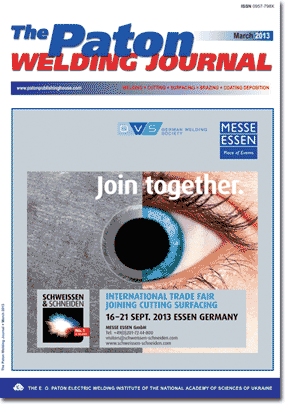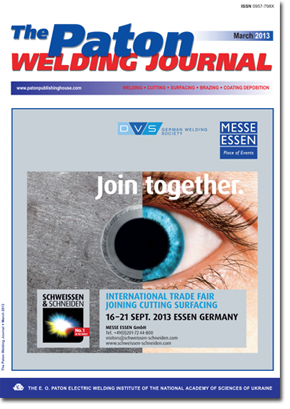| 2013 №03 (05) | 2013 №03 (07) |

The Paton Welding Journal, 2013, #3, 28-33 pages
EFFECT OF SIZE OF THE GAP AND INITIAL STATE OF THE BRAZING FILLER ALLOY ON FORMATION OF STRUCTURE OF THE TITANIUM ALLOY BRAZED JOINTS
S.V. MAKSYMOVA, V.F. KHORUNOV and V.V. VORONOV
E.O. Paton Electric Welding Institute, NASU, Kiev, Ukraine
Abstract
Brazing filler alloys of the Ti-Zr-Ni-Cu system in both amorphous and crystalline states are widely applied in brazing of titanium and its alloys. It is reported that brazing with amorphous filler alloys creates special conditions for formation of the joints, the issue of the effect of size of the brazing gap being neglected. This issue was investigated in this study. Special samples of titanium alloy OT4 (Ti-3Al-1.5Mn) were brazed in vacuum with the fixed variable gap by using filler alloy Ti-23Cu-12Zr-12Ni in the amorphous and crystalline states to conduct comparative metallographic examinations. It was found that microstructure and chemical composition of the phases solidifying in a wide region of the seam of the joints brazed by using amorphous filler alloy Ti-23Cu-12Zr-12Ni are similar to those of the wide seams brazed with the cast filler alloy of the same composition. Primary solid solution grains and eutectic were clearly detected in structure of the seams. In the capillary gaps the seam is a diffusion zone with common base metal grains enriched with the filler alloy components, in case of brazing using both amorphous and crystalline filler alloys. Occurrence of the diffusion processes at interface between the phases is proved by the X-ray spectral analysis results. At a concentration of zirconium in the seam equal to 16.39 wt.% its concentration at a distance of approximately 100 mm deep into the base metal decreases to 1.22 wt.%, and at a distance of 150 mm zirconium is not detected at all. As shown on the basis of the results of metallographic examinations and X-ray spectrum microanalysis of the titanium joints, the decisive factor in formation of microstructure of the seams is size of the brazing gap, which determines the morphological state of the seam. 8Ref., 5 Tables, 8 Figures.
Keywords: titanium alloy, brazing filler alloy, gap size, joint, amorphous and crystalline state, brazed seam, microstructure
Received: 13.12.13
Published: 28.03.13
References
1. Kovneristy, Yu.K. (1992) Amorphous vitreous metallic materials. Moscow: Nauka.
2. Kalin, B.A., Sevryukov, O.N., Fedotov, B.T. (1996) Amorphous strip filler alloys for brazing. Experience of development of the production and application technology. Svarochn. Proizvodstvo, 1, 15-19.
3. Kalin, B.A., Fedotov, V.T., Sevryukov, O.N. et al. (2001) Rapidly quenched filler alloy for brazing of metal structures. Perspekt. Materialy, 6, 82-87.
4. Kalin, B.A., Sevryukov, O.N., Fedotov, V.T. (1996) Brazing of thin-sheet structures of titanium alloys with amorphous filler alloys STEMET. Svarochn. Proizvodstvo, 9, 23-24.
5. Khorunov, V.F., Maksymova, S.V. (2005) Production and application of rapidly quenched filler alloys. Ibid., 12, 25-30.
6. Kalin, B.A., Sevryukov, O.N., Fedotov, V.T. et al. (2001) New amorphous filler alloys for brazing of titanium and its alloys. Ibid., 3, 37-39.
7. Shpak, A.P., Kunitsky, Yu.A., Lysov. V.I. (2002) Cluster and nanostructural materials. Vol. 2. Kiev: Akademperiodika.
8. Maksymova, S.V. (2007) Amorphous filler alloys for brazing of stainless steel and titanium, and structure of brazed joints. Adgeziya Rasplavov i Pajka Materialov, 40, 70-81.
Suggested Citation
S.V. MAKSYMOVA, V.F. KHORUNOV and V.V. VORONOV (2013) EFFECT OF SIZE OF THE GAP AND INITIAL STATE OF THE BRAZING FILLER ALLOY ON FORMATION OF STRUCTURE OF THE TITANIUM ALLOY BRAZED JOINTS. The Paton Welding J., 03, 28-33.The cost of subscription/purchase order journals or individual articles
| Journal/Currency | Annual Set | 1 issue printed |
1 issue |
one article |
| TPWJ/USD | 384 $ | 32 $ | 26 $ | 13 $ |
| TPWJ/EUR | 348 € | 29 € | 24 € | 12 € |
| TPWJ/UAH | 7200 UAH | 600 UAH | 600 UAH | 280 UAH |
| AS/UAH | 1800 UAH | 300 UAH | 300 UAH | 150 UAH |
| AS/USD | 192 $ | 32 $ | 26 $ | 13 $ |
| AS/EUR | 180 € | 30 € | 25 € | 12 € |
| SEM/UAH | 1200 UAH | 300 UAH | 300 UAH | 150 UAH |
| SEM/USD | 128 $ | 32 $ | 26 $ | 13 $ |
| SEM/EUR | 120 € | 30 € | 25 € | 12 € |
| TDNK/UAH | 1200 UAH | 300 UAH | 300 UAH | 150 UAH |
| TDNK/USD | 128 $ | 32 $ | 26 $ | 13 $ |
| TDNK/EUR | 120 € | 30 € | 25 € | 15 € |
AS = «Automatic Welding» - 6 issues per year;
TPWJ = «PATON WELDING JOURNAL» - 12 issues per year;
SEM = «Electrometallurgy Today» - 4 issues per year;
TDNK = «Technical Diagnostics and Non-Destructive Testing» - 4 issues per year.


